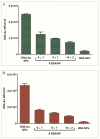Scavenger receptors mediate cellular uptake of polyvalent oligonucleotide-functionalized gold nanoparticles
- PMID: 21070003
- PMCID: PMC3241523
- DOI: 10.1021/bc1002423
Scavenger receptors mediate cellular uptake of polyvalent oligonucleotide-functionalized gold nanoparticles
Abstract
Mammalian cells have been shown to internalize oligonucleotide-functionalized gold nanoparticles (DNA-Au NPs or siRNA-Au NPs) without the aid of auxiliary transfection agents and use them to initiate an antisense or RNAi response. Previous studies have shown that the dense monolayer of oligonucleotides on the nanoparticle leads to the adsorption of serum proteins and facilitates cellular uptake. Here, we show that serum proteins generally act to inhibit cellular uptake of DNA-Au NPs. We identify the pathway for DNA-Au NP entry in HeLa cells. Biochemical analyses indicate that DNA-Au NPs are taken up by a process involving receptor-mediated endocytosis. Evidence shows that DNA-Au NP entry is primarily mediated by scavenger receptors, a class of pattern-recognition receptors. This uptake mechanism appears to be conserved across species, as blocking the same receptors in mouse cells also disrupted DNA-Au NP entry. Polyvalent nanoparticles functionalized with siRNA are shown to enter through the same pathway. Thus, scavenger receptors are required for cellular uptake of polyvalent oligonucleotide functionalized nanoparticles.
Figures






Similar articles
-
Oligonucleotide-conjugated nanoparticles for targeted drug delivery via scavenger receptors class A: An in vitro assessment for proof-of-concept.Int J Pharm. 2017 Oct 30;532(1):647-655. doi: 10.1016/j.ijpharm.2017.08.074. Epub 2017 Aug 18. Int J Pharm. 2017. PMID: 28827202
-
Polyvalent oligonucleotide gold nanoparticle conjugates as delivery vehicles for platinum(IV) warheads.J Am Chem Soc. 2009 Oct 21;131(41):14652-3. doi: 10.1021/ja9071282. J Am Chem Soc. 2009. PMID: 19778015 Free PMC article.
-
Polyvalent oligonucleotide iron oxide nanoparticle "click" conjugates.Nano Lett. 2010 Apr 14;10(4):1477-80. doi: 10.1021/nl100477m. Nano Lett. 2010. PMID: 20307079 Free PMC article.
-
Intracellular Trafficking and Endosomal Release of Oligonucleotides: What We Know and What We Don't.Nucleic Acid Ther. 2018 Jun;28(3):166-177. doi: 10.1089/nat.2018.0727. Epub 2018 Apr 30. Nucleic Acid Ther. 2018. PMID: 29708838 Free PMC article. Review.
-
Integrated nanoparticle-biomolecule systems for biosensing and bioelectronics.Biosens Bioelectron. 2007 Apr 15;22(9-10):1841-52. doi: 10.1016/j.bios.2006.09.018. Epub 2006 Oct 30. Biosens Bioelectron. 2007. PMID: 17071070 Review.
Cited by
-
Nanoparticle clearance is governed by Th1/Th2 immunity and strain background.J Clin Invest. 2013 Jul;123(7):3061-73. doi: 10.1172/JCI66895. Epub 2013 Jun 17. J Clin Invest. 2013. PMID: 23778144 Free PMC article.
-
Nanobarcoding: detecting nanoparticles in biological samples using in situ polymerase chain reaction.Int J Nanomedicine. 2012;7:5625-39. doi: 10.2147/IJN.S37433. Epub 2012 Nov 2. Int J Nanomedicine. 2012. PMID: 23144562 Free PMC article.
-
A comparative analysis of cell surface targeting aptamers.Nat Commun. 2021 Nov 1;12(1):6275. doi: 10.1038/s41467-021-26463-w. Nat Commun. 2021. PMID: 34725326 Free PMC article.
-
Nanoparticle-cell interactions: molecular structure of the protein corona and cellular outcomes.Acc Chem Res. 2014 Aug 19;47(8):2651-9. doi: 10.1021/ar500190q. Epub 2014 Jul 11. Acc Chem Res. 2014. PMID: 25014679 Free PMC article.
-
The Impact of Protein Corona Formation on the Macrophage Cellular Uptake and Biodistribution of Spherical Nucleic Acids.Small. 2017 Apr;13(16):10.1002/smll.201603847. doi: 10.1002/smll.201603847. Epub 2017 Feb 14. Small. 2017. PMID: 28196309 Free PMC article.
References
-
- Mirkin CA, Letsinger RL, Mucic RC, Storhoff JJ. A DNA-based method for rationally assembling nanoparticles into macroscopic materials. Nature. 1996;382:607–609. - PubMed
-
- Park SY, Lytton-Jean AK, Lee B, Weigand S, Schatz GC, Mirkin CA. DNA-programmable nanoparticle crystallization. Nature. 2008;451:553–556. - PubMed
-
- Nykypanchuk D, Maye MM, van der Lelie D, Gang O. DNA-guided crystallization of colloidal nanoparticles. Nature. 2008;451:549–552. - PubMed
-
- Nam J-M, Thaxton CS, Mirkin CA. Nanoparticle-based bio-bar codes for the ultrasensitive detection of proteins. Science. 2003;301:1884–1886. - PubMed
-
- Elghanian R, Storhoff JJ, Mucic RC, Letsinger RL, Mirkin CA. Selective colorimetric detection of polynucleotides based on the distance-dependent optical properties of gold nanoparticles. Science. 1997;277:1078–1081. - PubMed
Publication types
MeSH terms
Substances
Grants and funding
LinkOut - more resources
Full Text Sources
Other Literature Sources
Miscellaneous

